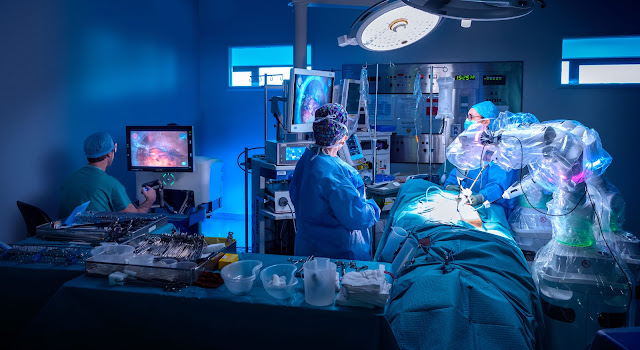Global Surgical Robots Market Is Estimated To Witness High Growth Owing to Increasing Adoption of Minimally Invasive Surgeries and Technological Advancements
 |
| Surgical Robots Market |
The
global Surgical Robots Market is estimated to be valued at US$ 5,721.6 million
in 2022 and is expected to exhibit a CAGR of 13.4% over the forecast period
2022-2030, as highlighted in a new report published by Coherent Market
Insights.
A) Market Overview:
Surgical robots are advanced medical devices that assist surgeons in performing minimally invasive surgeries with precision and accuracy. These robots consist of robotic arms, cameras, and surgical instruments controlled by a surgeon. They provide magnified 3D images of the surgical site and enable surgeons to perform complex procedures with smaller incisions, reduced blood loss, faster recovery time, and lesser post-operative complications.
B)
Market Dynamics:
The key drivers fueling the growth of the Surgical Robots Market include the increasing adoption of minimally invasive surgeries and technological advancements in robotic surgery systems. Minimally invasive surgeries offer several benefits compared to traditional open surgeries, such as reduced pain, minimal scarring, shorter hospital stays, and faster recovery. As a result, there is a growing demand for surgical robots that enable precise and efficient minimally invasive procedures.
Furthermore, technological advancements in surgical robots have led to improved functionalities and better patient outcomes. For instance, the da Vinci Surgical System by Intuitive Surgical is one of the most widely used surgical robots, offering features like enhanced vision, greater range of motion, and better control for surgeons. Such advancements are driving the adoption of surgical robots in various medical specialties, including urology, gynecology, cardiovascular surgery, and orthopedics.
C)
Market Key Trends:
One key trend observed in the Surgical Robots Market is the increasing use of artificial intelligence (AI) and machine learning (ML) technologies. AI and ML algorithms can analyze vast amounts of patient data and provide real-time insights to surgeons, aiding in decision-making and improving surgical outcomes. For example, the Versius Surgical System by CMR Surgical incorporates AI and ML algorithms that learn from the surgeon's movements and assist in performing complex procedures with greater precision.
D)
SWOT Analysis:
Strengths:
1.
High precision and accuracy in surgeries.
2. Faster recovery time for patients.
Weaknesses:
1.
High initial costs of surgical robots.
2. Complex maintenance and training requirements.
Opportunities:
1.
Growing demand for robotic-assisted surgeries in emerging economies.
2. Expansion of surgical robot applications in new medical specialties
Threats:
1.
Stringent regulatory requirements for surgical robots.
2. Potential risks associated with technical malfunctions or errors during surgery.
E)
Key Takeaways:
1. The
global Surgical Robots Market is expected to witness high growth, exhibiting a
CAGR of 13.4% over the forecast period, due to increasing adoption of minimally
invasive surgeries and technological advancements.
2. North
America is currently the fastest-growing and dominating region in the global
surgical robots market, attributed to the presence of key market players,
advanced healthcare infrastructure, and favorable reimbursement policies.
3. Key players operating in the global Surgical Robots Market include Intuitive Surgical, Think Surgical, Asensus Surgical US, Inc., Zimmer Biomet, Stryker, Smith & Nephew, Novus Health Products, and Medtronic. These companies focus on product development, strategic collaborations, and mergers and acquisitions to strengthen their market position.
In
conclusion, the global Surgical Robots Market is witnessing significant growth
due to the increasing adoption of minimally invasive surgeries and
technological advancements. The integration of AI and ML technologies and the
expanding applications of surgical robots present lucrative opportunities for
market players. However, high costs and complex maintenance requirements pose
challenges to market growth. Overall, the market is expected to continue its
upward trajectory, driven by the demand for precision, efficiency, and improved
patient outcomes in surgical procedures.



Comments
Post a Comment